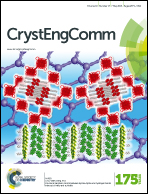A kinetic model for two-step phase transformation of hydrothermally treated nanocrystalline anatase†
Abstract
A kinetic model that enables quantitative assessment of the contribution to the rate of phase transformation by dissolution–precipitation and by interface–nucleation has been developed. Results demonstrate that, under highly acidic, hydrothermal conditions, anatase phase transforms to rutile predominantly by dissolution–precipitation, presumably due to the comparatively high solubility of TiO2 at 250 °C and pH 1.0. In contrast, the phase transformation is dominated by interface–nucleation at pH 3.0, at which the solubility of TiO2 is substantially lower. Furthermore, kinetic data for the phase transformation at the intermediate pH of 2.2 were fit poorly by the interface–nucleation and dissolution–precipitation models individually but fit well using the new kinetic model. Generally speaking, interface–nucleation plays a critical role during the early stages of the transformation, regardless of pH, whereas dissolution–precipitation dominates the later stages of the transformation. The contribution to the rate of rutile production by dissolution–precipitation is the greatest under conditions of higher titania solubility. However, even under conditions of higher titania solubility, results are consistent with interface–nucleation playing a crucial role in producing the initial rutile crystallites, which subsequently grow by dissolution–precipitation. Transmission electron microscopy results are consistent with the results obtained by the new model. Thus, new insights into the mechanism of the anatase to rutile phase transformation under hydrothermal conditions are gained, enabling quantitative assessment of the contribution by interface–nucleation.


 Please wait while we load your content...
Please wait while we load your content...